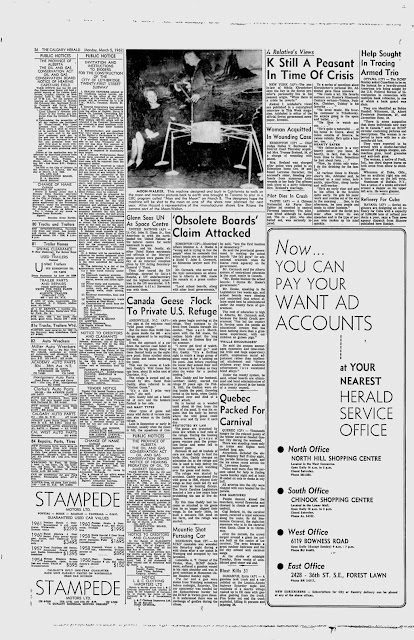 |
| The Calgary Herald June 9, 1962 Page 5 |
Transcript:
LUNAR TRAVEL - Plans Advanced For Exploration
After the Apollo spacecraft briefly lands its three-man crew on the moon and brings them back safely, what is the United States' next step in lunar exploration?
A California engineer has an answer - he says a 12-man expedition could carry out a 500-mile research trip across the surface of the moon by 1970.
The basic plan for the expedition has been worked out by Allyn B. Hazard, in El Monte, Cal. The idea had its beginning three years go, with Hazard's study of equipment needed for moon exploration at the California Institute of Technology's jet propulsion laboratory.
Four giant rockets would be used on Hazard's proposed moon trip: three round trip passenger vehicles and the other a one-way cargo carrier with 15 tons of supplies and equipment. It would carry everything needed to support the astronauts during a 21-day "out of this world" journey.
Highly-Trained Group Required
Each of the 12 men would be a highly trained scientist or technologist in some field and each would have to acquire some of the skills of the others, to provide vital "back-up" capability.
On the moon, only four of the astronauts would set off on the 500-mile trans-lunar trek. The group would include a geologist, a physicist, a medical - human factors specialist, and a communications - equipment specialist. Other members of the expedition would remain at the landing site to conduct research and maintain contact with earth, living in the space ships.
The four-man overland party wouldn't enjoy such luxury. Their trip would take about 10 earth days, and would be made during the 330-hour lunar night, to avoid danger of radiation from solar flares.
With no other shelter, they would have to live, work, eat, and sleep in special tub-like space suit "shells," like turtles. These would be their only protection from the moon's airlessness and night time cold of 250 degrees below zero.
Suit Livable For Long Period
The peculiar pot-belly shape is designed to make the suit more livable for a long period. The wearer can slip his arms out of the sleeves to prepare food stored inside, eat, adjust controls, make notes, or just to scratch his nose.
The suit's spaciousness and its "look all around" windows (including one in the bottom of the tub so the wearer can watch his step) eliminate all feeling of claustrophobia an important psychological factor over a 10-day trip.
The explorers would ride on tractor like electric powered moon mobiles, two to a cart, rolling over the moon's rough surface at about five miles an hour. They would be at opposite ends, suspended just above the ground by trunions attached to the sides of their suits. To sleep they would merely pivot back into a horizontal position, and doze off on the suit's thickly padded back, with a built-in pillow.
Supplies
Air, water, and power supplies for the space suits would be carried on the moon mobiles, and piped to the astronauts through long "umbilical" connections that would allow them to get off the (sic) walk alongside, collecting samples, making experiments, or taking pictures.
Each suit would also have built-in air and water tanks and a separate power supply, so the explorers could disconnect the "umbilicals" and leave their vehicles for a limited time if necessary.
"The Integrated moon suit - moon mobile idea offers the best and quickest way for man to really explore the moon's surface with the light-weight equipment we can land there in the next 10 years," Hazard says. In actual service, the problems of bulkiness and weight in the hard-shell space suit will be relieved by the moon's light gravity just one-sixth that of the earth.
All images, captions and content are
Copyright © 1997-2025 John Eaton unless otherwise stated. If there are
any comments or objections, please contact John Eaton, by clicking here.


















